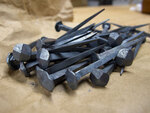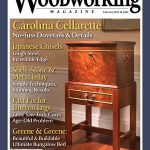We may receive a commission when you use our affiliate links. However, this does not impact our recommendations.
I bought a box of 1,600 pneumatic nails about two presidential administrations ago that cost about a half penny each (yes, I know I overpaid). So why in the world would I buy a box of 40 nails for – cough – $1.50 each?
Easy. Hardware is as important to me as every other aspect of my projects, from the wood to the design to the finish. And once you see and use a handmade nail, you are ruined.
Good nails are a slippery slope. I started years ago by buying masonry nails, which are hardened cut nails. These cost about a couple pennies each and look like an old-fashioned fastener. But they are too hard to clench, and recently the Chinese copies of the masonry nails have pushed out the domestic suppliers at my hardware store.
The Chinese masonry nails don’t look or perform like the U.S.-made ones.
So I turned to Tremont Nail Co. several years ago and have been using their nails with great success. Tremont has been in business since before the Civil War and manufacture some quality nails.
I use the “clinch rosehead standards” for installing backs and bottoms. The “fine finish standards” are good for case construction. And the “cut headless brads” are good for installing moulding, when I can manage to donate some plasma.
But earlier this year, Peter Follansbee encouraged me to use blacksmith-made nails in my projects. He works at Plimoth Plantation, and the village has a blacksmith that makes his nails. When I visited Peter at Plimoth this summer, I took a long look at his hardware, from the nails to the drawer pulls that they cast in the sand on the beach.
I was impressed and inspired to try some of these nails.
So this fall I asked blacksmith Peter Ross to make me some 6d nails for some upcoming projects – a six-board chest and a Dutch tool chest. They arrived this week, and I am even more nail-crazy than before. I can’t wait to put these to use. Their heads have a beautiful pyramid shape. The shanks are long, thin and tapering.
They are finer than the Tremont nails to be sure. They should be – handmade nails cost about $1.50 each. (I think you can immediately see why apprentices were told to straighten all the bent nails in a pre-Industrial shop.)
I also finished reading the short book “Nailmaking” (Shire Library) by Hugh Bodey, which convinced me that I never wanted to make nails –it’s fairly miserable and montonous. So purchased nails are fine by me.
I have several projects in the coming year where I will be using these handmade nails. I’ll be sure to take some photos of them and post them on the blog.
— Christopher Schwarz
Here are some supplies and tools we find essential in our everyday work around the shop. We may receive a commission from sales referred by our links; however, we have carefully selected these products for their usefulness and quality.















The Peter Ross nails are beautiful, it’s almost a shame to hide them.
Fur coats on Chris. I look forward to the next post on why solid-gold furniture is totally underrated, and the one after that on how to light cigars with hundred-dollar bills.
What? Expensive handmade nails in a plastic box? Scandalous!
I have never used nails or screws in furniture construction. That said, i read your post on hand made nails, I followed all the links and was very impressed. Then I remembered that screws hold better than nails. so I looked up info on screws. I was surprised. I hope you will be as well. http://inventors.about.com/od/sstartinventions/a/screwdriver.htm
Thanks Chris you always provide great posts
I know of another excellent smith, Jonathan Nedbor in Ulster County New York, who makes all types of period nails as well as historical hardware. I took a class with him years ago and yes, making a simple nail is anything but. It was important practice for the apprentice to learn how to draw a taper, upset the end and keep several “irons in the fire” so as to not lose time waiting for the cooled metal to reheat for the next step.
Here is the link:
hudsonvalleyblacksmith.com
I’m pretty lucky as far as nails go. when I did work on my 1837 house I saved all the nails. My father in law found a can of nails in the rafters of his house. the house is from about 1900 the nails look to be much older hand cut nails with their size inconstantcies normally found in the early 1800. And My wife had an uncle who saved the hand forged nails he got when “improving” old furniture, so I also have a coffee can full of those.
I also have a coffee can full of hand made screws.
Now I need the time to use them!
Years ago, I asked my granddad why he was saving nails, he said he wasn’t, he was saving saw blades.
More to the topic, I visited England’s Black Country Museum a number of years back, and they showed the forge where women and children made spikes an nails as piece work.
It does lend new weight to the question: Can I borrow a handful of nails?
This is one of those things, as a woodworker, that I will have to buy and find the right project for!
Nail straightening didn’t end with the industrial revolution. In the early 70s, my dad poured concrete as a second job and I spent quite a few Sundays pulling tons of 3″ spiral nails out of the forms – then straightening them all on the corner of a cinder block. It was supposed to teach me thrift and sticktoitiveness. I now suspect it just got me out of the house so he and Mum could have some time alone.
Great success. Very nice.
In the two comparison photos, the top nail is the Tremont, yes?
Peter is truely a master of this type of work. I’ve made nails and don’t know how full time nail makers of old managed to keep their sanity.
“Nailmaking”?… I would that that was all about cuticles and French tips.
I used tons of these nails (bought at Lee Valley) on the pine flooring that I made from pine trees from our property. They are very good quality and are still holding very well after 7 years. They would look great on antique looking furniture too.